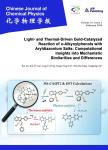Non-adiabatic Couplings Induced Complex-Forming Mechanism in H+MgH^(+)→Mg^(+)+H_(2) Reaction
H+MgH^(+)→Mg^(+)+H_(2)反应中由非绝热耦合引起的复合物形成反应机理作者机构:Key Laboratory of Materials Modification by LaserElectronand Ion Beams(Ministry of Education)School of PhysicsDalian University of TechnologyDalian 116024China
出 版 物:《Chinese Journal of Chemical Physics》 (化学物理学报(英文))
年 卷 期:2022年第35卷第2期
页 面:345-352,I0003页
核心收录:
学科分类:081704[工学-应用化学] 07[理学] 070304[理学-物理化学(含∶化学物理)] 08[工学] 0817[工学-化学工程与技术] 0703[理学-化学]
基 金:supported by the National Natural Science Foundation of China(No.11774043)
主 题:Quantum dynamics Non-adiabaitc reaction Wave packet method
摘 要:A chemical process may involve multiple adiabatic electronic states, and non-adiabatic couplings play an important role in the reaction mechanism. In this work, the effect of non-adiabatic couplings in the H+MgH;→Mg;+H;reaction are studied using the time-dependent wave packet method and trajectory surface hopping method. The calculated results show that the reaction follows a direct abstraction process when the non-adiabatic couplings are neglected. However, when non-adiabatic couplings are included in the calculations, a longlived excited state complex(MgH_(2)+)*can be formed during the reaction. These direct and complex-forming reaction pathways are revealed by trajectory surface hopping *** non-adiabatic couplings induced complex-forming mechanism not only increases the reactivity but also has significant effect on the product vibrational state distribution.



